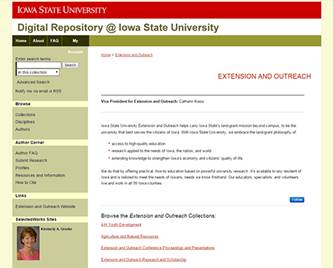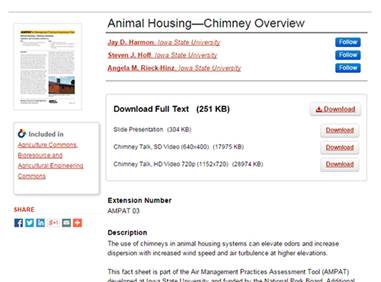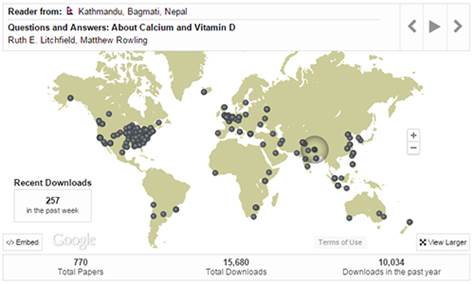 |
October 2015
|
October 2015 // Volume 53 // Number 5 // Tools of the Trade // v53-5tt1
Building Connections, Collections, and Communities: Increasing the Visibility and Impact of Extension Through Institutional Repositories
Abstract
Over the past 20 years, university libraries have developed and manage institutional repositories—digital libraries that provide free, public access to the research, scholarship, and publications of their university's faculty, staff, and students. Although underused by Extension professionals, institutional repositories are powerful tools that can be used to raise the global visibility of Extension scholarship, highlight resources from individual initiatives and projects, provide readership statistics to demonstrate impact, and create digital archives to create topical collections and to facilitate study on the history of Extension.
The Internet is a powerful tool that can disseminate information to a global audience. Extension professionals have been exploring the use of developing Web-based technologies, using social media networks (Gharis, Bardon, Evans, Hubbard, & Taylor, 2014) and mobile applications (Typhina, Bardon, & Gharis, 2015) to disseminate information to the public, provide educational opportunities, and build communities. They are building wikis to facilitate collaboration (Kinsey & Carrozzino, 2011), using online course delivery software to conduct training and certification programs (Cottle & D'Angelo, 2015), and developing communities of practice to connect with Extension colleagues and provide venues for disseminating digital scholarship (Clevenger & Watters, 2014; Raison, Fox, & D'adamo-Damery, 2014; Stafne, 2013).
Over the past 20 years, university libraries have been developing institutional repositories (IRs)—digital libraries that provide public access to scholarship created by a university's faculty, students, and staff. Although originally focused on journal articles, IRs have grown to include a range of materials, including conference proceedings, theses, dissertations, white papers, and technical reports.
Roberts, Vyhnanek, and Rao (2012) describe some of the technical benefits of using IRs to build archives of Extension research. However, although IRs provide many opportunities for Extension professionals, they remain an underused resource. A recent examination of IRs at land-grant universities found that only five were collecting Extension publications (Becker & Monks, 2013).
Institutional Repositories and the Land-Grant Mission
The development of the Cooperative Extension system enshrined the dissemination of knowledge and access to education beyond campus borders as one of the primary missions of the land-grant university (Rasmussen, 1989). This mirrors the purpose of IRs. IRs seek to increase access to the scholarly record, traditionally only accessible to scholars affiliated with libraries having the resources to subscribe to expensive journals and databases. By providing free, public access to the research and scholarship authored by a university's faculty, staff, and students, including Extension professionals, IRs have the potential to support a university's efforts to meet their land-grant mission. In turn, repositories give Extension professionals a new method to expand the reach of their scholarship to the people they are charged with serving as faculty and staff at a land-grant university.
Opportunities for Extension Professionals
Institutional repositories can catalyze and solidify connections between Extension and academic departments and between applied research and basic research. Participating in IRs provides opportunities for Extension professionals to engage more fully with university libraries, tapping into librarians' expertise in organizing, preserving, describing, positioning, and disseminating information.
By partnering with university libraries to create Extension collections within IRs and to digitize and add historical Extension publications, IRs become digital archives that create increased opportunities for research into the history of Extension. The history of agriculture, human sciences, economic development, and public policy, as told through Extension publications, is also highlighted.
IRs provide many practical benefits for Extension professionals.
- Librarians can assist in checking the copyright status of Extension materials that have been previously published and seek permission to include these materials in repository collections.
- When Extension bulletins fall out of currency, they are removed from Extension websites. This creates problems if these bulletins are cited or if links are included in Extension professionals' vitae and external websites. IRs provide stable URLs, so links will not break when these publications become outdated or when Extension websites are reorganized.
- IRs may provide authors with readership reports, indicating how many times their publications have been downloaded. These reports demonstrate impact and can be included in tenure and promotion portfolios and other performance reviews.
- By creating inclusive repository communities, connections between a department's applied research and basic research are made visible, and, in turn, Extension work may be more visible.
- The increased visibility of Extension work provided by IRs can also lead to opportunities for speaking engagements, grant projects, and other collaborative connections for Extension professionals.
Institutional Repositories in Action
Since its launch in 2012, the Digital Repository @ Iowa State University (http://lib.dr.iastate.edu) has provided a venue to showcase the scholarship of Iowa State University, including its Extension faculty and staff. Like many IRs, the Digital Repository @ Iowa State University is organized into communities that reflect departments and units of the university. Iowa State University Extension and Outreach has its own community page in the repository (Figure 1) featured prominently on its home page.
Figure 1.
The Extension and Outreach Community in Digital Repository @ Iowa State University (http://lib.dr.iastate.edu/extension/)
Digital Repository @ Iowa State University has experimented with ways to showcase Iowa State University's Extension and outreach activities, widely disseminate Extension-produced materials, and highlight connections between Iowa State University Extension and Outreach and academic departments. These efforts include:
- Providing a disclaimer to alert users that Extension bulletins may contain outdated information, providing a link to the Extension website where they can obtain current information.
- Providing Extension and outreach collections within academic department community pages to highlight Extension work done by the department's faculty and staff.
- Creating communities for individual Extension programs, bringing together all resources regardless of format. For example, visitors to the Agricultural Health and Safety collection can view Safe Farm Extension bulletins, listen to Safe Farm Minute radio recordings, and read articles reflecting on the success of the Safe Farm program (http://lib.dr.iastate.edu/safefarm/).
- Grouping related content, allowing users to download Extension bulletins and related slideshows, videos, and other materials from a single webpage (Figure 2).
- Displaying thumbnails of Extension bulletin covers to make the collections more attractive and engaging for a public audience.
- Providing downloadable statistics that can be used to demonstrate impact in evaluation, performance reviews, reports to funders, and tenure and promotion portfolios.
- Creating Selected Works profiles for Extension faculty and staff that provide a single point of access for their scholarly output, including Extension bulletins, reports, journal articles, educational resources, and more (Figure 3).
Figure 2.
Supporting Materials Available for Downloads alongside Extension Bulletins (http://lib.dr.iastate.edu/extension_ag_pubs/209/)
Figure 3.
Selected Works Profile of Nancy Franz (http://works.bepress.com/nancy_franz/)
In April 2015, the Extension and Outreach community in Digital Repository @ Iowa State University held 770 publications, which have been downloaded over 15,500 times (Figure 4). To begin including Extension publications within IRs, contact the librarian in charge of your institutional repository to discuss the scope and capabilities of the repository and to arrange the delivery of Extension materials to the repository.
Figure 4.
The Readership Map for Extension and Outreach Showing Number of Items, Downloads, and the Location of Readers
References
Becker, D. C., & Monks, K. M. (2013). Slicing and dicing the digital preservation and dissemination of land grant Research: A survey of and model for digital collections of Agricultural Experiment Station and Extension publications. Journal of Agricultural & Food Information, 14(3) 225–241. doi:10.1080/10496505.2013.793163.
Clevenger, W. B., & Watters, H. D. (2014). Developing an on-farm research network: Published work for peers and producers. Journal of Extension [On-line], 52(4) Article 4TOT6. Available at: http://www.joe.org/joe/2014august/tt6.php
Cottle, L., & D'Angelo, N. (2015). Online leader training course: Nebraska equine Extension leader certification. Journal of Extension [On-line], 52(1) Article 1TOT5. Available at: http://www.joe.org/joe/2015february/tt5.php
Gharis, L. W., Bardon, R. E., Evans, J. L., Hubbard, W. G., & Taylor, E. (2014). Expanding the reach of Extension through social media. Journal of Extension [On-line], 52(3) Article 3FEA3. Available at: http://www.joe.org/joe/2014june/a3.php
Kinsey, J., & Carrozzino, A. L. (2011). Working in a wiki: A tool for collaboration among virtual teams. Journal of Extension [On-line], 49(6) Article 6TOT4. Available at: http://www.joe.org/joe/2011december/tt4.php
Raison, B., Fox, J. M., & D'Adamo-Amery, P. (2014). Crowdsourcing eXtension: Communities of practice provide rapid response. Journal of Extension [On-line], 52(6) Article 6TOT2. Available at: http://www.joe.org/joe/2014december/tt2.php
Rasmussen, W. (1989). Taking the university to the people: Seventy-five years of Cooperative Extension. Ames, IA: Iowa State University Press.
Roberts, D., Vyhnanek, K., & Rao, S. (2012). Multi-agency team uses university archival tool to conserve vital project information. Journal of Extension [On-line], 50(2) Article 2TOT8. Available at: http://www.joe.org/joe/2012april/tt8.php
Stafne, E. T. (2013). A view of digital scholarship in Extension. Journal of Extension [On-line], 51(5) 5COM1. Available at: http://www.joe.org/joe/2013october/comm1.php
Typhina, E., Bardon, R. E., & Gharis L. W. (2015). Collaborating with your clients using social media & mobile communications. Journal of Extension [On-line], 53(1) Article 1TOT2. Available at: http://www.joe.org/joe/2015february/tt2.php




